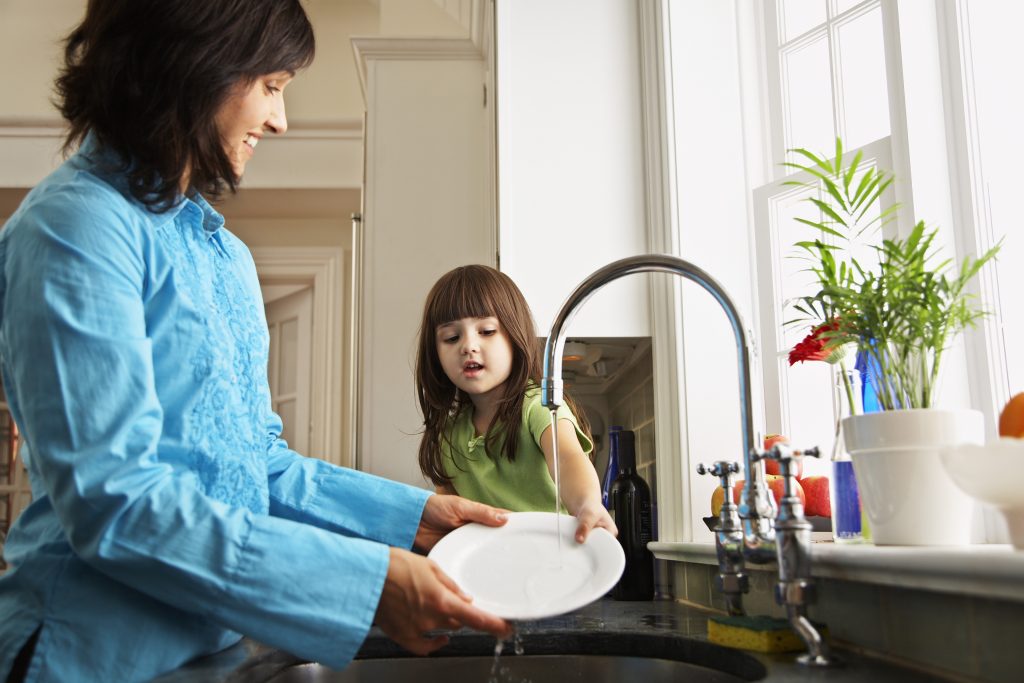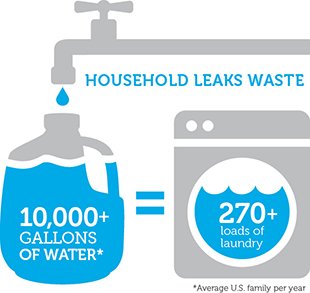Water covers about 71% of the earth’s surface, but most of that water – over 96% – is saline water in the oceans. The rest is freshwater, but only about 1.2% of the supply is available for people to use every day for drinking, washing, growing food, etc. Because freshwater is such a finite resource, it’s especially important to conserve water and help prevent water pollution.
On average, each person in the United States uses 82 gallons of water a day. To reduce that average, here are 10 easy ways to conserve water in your home:

1. Taps off.
Don’t leave a bathroom faucet running when not in use. Switch off the water source while brushing, soaping hands or shaving. Turning off the tap while brushing can save 8 gallons of water per day. Doing the same while shaving can save 10 gallons per shave. That adds up to 5,700 gallons per year.
And, the same goes for the kitchen: don’t let the faucet run unnecessarily while washing dishes. A faucet running for 5 minutes can waste 10 gallons of water.
2. Scrape it.
Scrape your plate instead of rinsing it to save water. Be sure to put food waste in the compost pile instead of using the garbage disposal, which needs water to run.
3. Get steamy.
Steam your veggies. Steaming vegetables not only allows you to retain more nutrients, it also cuts water usage. If you choose to boil, try using the leftover water as a starter for soups. Or, cool it and water your plants.

4. Fix leaks.
Check your faucets and showerheads for drips and leaks. Household leaks can waste 180 gallons per week, or approximately 10,000 gallons per family each year. That’s about the same as 270 loads of laundry.
5. Go low-flow.
Install water-saving showerheads, faucet aerators and low-flow toilets to save water, energy and money. Low-flow units can reduce water usage by as much as 60 percent over standard fixtures. If all U.S. households installed water-saving features, we could save approximately 5.4 billion gallons of water each day.
According to the EPA, models labeled with the WaterSense designation must meet the following criteria:
- Low-flow toilets: no more than 1.5 gallons per flush (GPF)
- Low-flow faucets: less than 1.5 gallons per minute (GPM)
- Low-flow showerheads: under 2.5 GPM water flow
6. Bathe SMARTer.
Showers use less water than baths, as long as you’re watching your time.
In the U.S., the average shower lasts about 8 minutes. Each minute, the average showerhead has a water flow of 2.1 gallons – that’s an average of 16 gallons of water per shower! If each person reduced their shower time by one minute, we’d save 170 billion gallons each year. Do your part: reduce the amount of time you spend in the shower to save water.

7. Full loads.
Wash full loads of dishes and laundry. Only run the dishwasher when it’s full – you’ll eliminate one load per week. This simple step can save 320 gallons of water per year. When doing laundry, use the appropriate water-level setting or load size selection on the washing machine.
8. Wear it again.
Washing machines account for 22.1% of total water use in U.S. households. That’s an average of 10 gallons of water used per person, per day. By staying mindful of how often you wash each item of clothing, you can save water. Wear your tops and bottoms more than once before washing.
9. Sweep don’t spray.
Use a broom instead of an outdoor hose to clean patios, sidewalks, steps and driveways.
10. Lights out.
Water is used to cool power plants that generate the electricity we use every day. It takes 3,000-6,000 gallons of water to power one light bulb that’s been left on for 12 hours a day over the course of a year. Turning off the lights when not in use saves both water and energy!
Bonus: toilets aren’t trashcans.
Only flush the 3Ps: pee, poo and (toilet) paper to conserve water during wastewater collection and treatment. Everything else is non-flushable and belongs in the wastebasket.
Article written by Amy Steger






